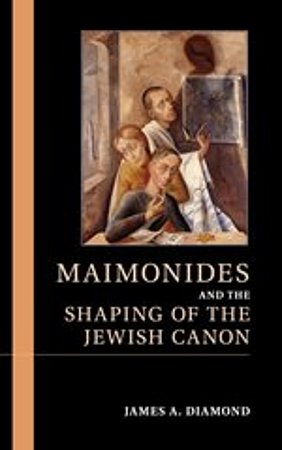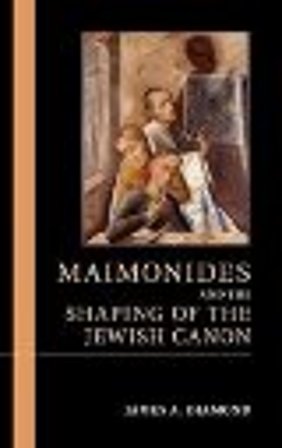While reading the philosophical treatises of Maimonides (1137-1204), but also, ironically, those of Baruch Spinoza (1632-77), one regularly encounters an age-old problem. At the end of almost every chapter, after the authors have presented and explained their philosophical and theological theses and theories, one often finds an extensive collection of biblical verses, which confirm these theses and, in a way, confer biblical authority onto religiously subversive philosophy. The modern reader, who prefers the strength of logical argument and the power of reason (as God’s gift or not) over the power of the “word of God,” is likely to skip those biblical passages.
James A. Diamond has written a whole book about exactly these biblical proof texts. The thesis of the book is not an implausible one. Ever since they first reached a public audience, the ideas of Moses Maimonides, one of the most important philosophers of the Jewish Middle Ages, have left a lasting impression on the canon of Jewish thinking and writing. At first glance one would think that this is far from surprising, and indeed not a groundbreaking revelation. Yet, as with many good books, the secret of its quality lies in the details. Diamond proves his simple point in a meticulous way that is incredibly rich in detail. He takes the philosophical works of eight Jewish thinkers into account—from Maimonides’s immediate successor Nachmanides up to almost the present day, to Hermann Cohen and Abraham Isaac Kook. To cope with the vastness of theological and legal details, Diamond examines these authors’ discussions of Maimonides almost exclusively with regard to the aforementioned verses, drawing on his thesis that the exegesis of the Bible is “the most Jewish of all exercises” (p. 187).
Diamond’s book relies in parts on previously published works, especially in regard to Isaac Abravanel’s, Spinoza’s, Cohen’s, and Kook’s engagements with Maimonides. However, they fit seamlessly into the larger framework of the book and are integrated with novel research about Nachmanides, and, importantly, with a number of lesser-known thinkers and their relation to Maimonides. Diamond discusses, for example, the brave defense of Maimonidean philosophy by Rabbi Yom Tov ben Abraham Ishbili (1250-1320), known in the rabbinic world as Ritva; the strong rejection of Maimonides for kabbalistic reasons by Meir Ibn Gabbai (1480-1540); or the suspiciously obvious silence with respect to the Maimonidean oeuvre in the works of the Lithuanian Rabbi Naftali Zwi Jehuda Berlin (1816-93), known as the Netziv.
This last example also reveals one of the methodological challenges of the book. Is the failure to take note of the great Maimonides when developing a certain theological exegesis a conscious strategy that in fact reflects an intensive engagement with Maimonides? Diamond’s answer is a definite yes. He claims that Maimonides’s influence was so overwhelming that one cannot even quote certain biblical passages without evoking Maimonides’s classic exegesis. Whether one mentions it directly or not, it remains within the exegetical and therefore Jewish theological discourse. Even the diffusion and mounting influence of the kabbalah, so Diamond boldly claims, would not have been possible without Maimonides. In the chapter about Meir Ibn Gabbai, he summarizes with this assertion: “Gabbai and other critical exponents of Jewish mysticism developed a contrapuntal hermeneutic composed of Maimonides’ rationalist point, and their own kabbalistic counterpoint, one that was shaped substantively and exegetically in the shadow of Maimonides’ own philosophical hermeneutic” (p. 161).
But still, how is this silent reaction compatible with the rationalistic religious philosophy of Maimonides’s Guide for the Perplexed? Here, Maimonides was admittedly groundbreaking as well. He proposed philosophical readings whose bravery and clarity are impressive to this day, and his interpretations were so bold that little remained of the literal meaning of the Bible. Yet, because of its very radicalism, this part of Maimonides’s thought did not become a classic of the Jewish-literary tradition. In Diamond’s chapter about the Netziv then, the interesting question emerges: if, for example, the Netziv does not directly mention Maimonides in his writings, but, unsurprisingly, unlike Maimonides, understands literally the existence of angels inhabiting heaven and earth, and not only as a “mere” linguistic symbolization of “forces of nature”—did the Netziv thus really enter a “critical dialogue” with Maimonides, as Diamond writes? This is harder to answer than it seems, because even radical minority opinions are often highly influential. However, the positive aspect of Diamond’s approach is immediately apparent here. For Diamond, the philosophical Guide for the Perplexed is as much an authentic-Jewish composition as are Maimonides’s works on religious law. Though up until well into the modern period the Guide had been dismissed on the basis of being influenced by “foreign” Greek philosophy, Diamond decidedly states that it belongs to the true “spirit of Judaism” (p. 266).
An even greater challenge for Maimonides and the Shaping of the Jewish Canon is the well-known problem that there is not one single Maimonides involved in the shaping of anything. Because of this, every modern and also premodern author writing about the great philosopher and halakhist only envisions a My-Monides. Which Maimonides is the one with which Diamond’s “heroes” enter a dialogue? Diamond solves this problem with ease and success by staying out of the debates about the “right Maimonides” for the most part—be it questions of esotericism versus exotericism, ethics versus pantheism, Halakha versus philosophy, etc.—and almost always hones in on exactly the version of Maimonides with which the concerned thinkers are struggling. Of course, this does not work throughout. Sometimes Diamond has to take sides, but he does so carefully, holding back his own opinions about the interpretation of Maimonides to let the protagonists speak for themselves. However, he consistently sides with Maimonides himself, which sometimes leads to rather broad generalizations. For example, Cohen and Kook are both accused of a “serious misreading” of Maimonides, while Diamond himself overlooks that there is a big difference between them (p. 263). Cohen is very much aware of his idiosyncratic interpretation and underpins it with strict methodology, while Rabbi Kook seems to believe that he has discovered the “true Maimonides.”
Here, one would have wished for more explanations, because not even the most systematic thought of Maimonides ever strictly represents the philosophical system of the Guide for the Perplexed. This is especially so because such a system, like the ones we are used to finding in modern rational thinkers, does not exist in Maimonidean thought. A phrase like “every component of this position is anathema to the entire of Maimonidean oeuvre” does not say much (p. 213). In any case, for Diamond, Maimonides’s “enigmatic and provocative style,” and his escape “from the Law’s parochial orbit into a universal philosophical enterprise” are the main causes for his lasting influence, and less so on account of some single provocative, but inconsistent idea (pp. 28, 66).
As a whole, the way the book demonstrates the theological diversity of Judaism from the Middle Ages until today, where the borders between strict dogma and independent thought are blurred, while only practiced religious law unites believers, is very impressive. For Maimonides, so Diamond claims, the biblical Abraham is the role model for a relentless rebuilding and renewing of a Judaism that therefore barely draws from tradition. Jewish identity, influenced by its Maimonidean understanding, is perpetuated—if Diamond is right—through ever-new, self-created convictions that, above all, stem from philosophical proof. In the end, however, Maimonides is still just one representative (even if he is the most influential) of rational Jewish theology, but not its originator (which would be reason itself).
Diamond’s general thesis is that, considering its influence on Judaism, Maimonides’s works present a kind of new Bible, or at least a new Talmud, that takes its place among those texts as part of the Jewish canon. Such a result may in fact not necessarily be against the stated intention of the medieval author. Ultimately, however, even Maimonides’s philosophy is only part of a rational approach within theology and therefore also part of a never-ending debate about the cognoscibility of God, the teleology of divine commands, and the possibility of a middle ground between atheism and orthodoxy. This is why many of his critics do not argue against Maimonides himself, but against this possibility. Many of his proponents rather argue for a Maimonides that provides a personalized historical proof, or legal authority, for the religious command of philosophizing.
It is only in the conclusion that Diamond finally discovers a thinker who openly distanced himself from any Maimonidean influence, or at least pretended to do so: Gershom Scholem. Scholem, who had accused so many others of being prejudiced against certain parts of Jewish culture and history, openly proclaimed that only the Bible, the Zohar, and Franz Kafka constitute the canon of authentic Jewish literature. Secretly Scholem added in his famous letter to Salman Schocken in 1937 that Maimonides in particular had always “appalled” him. But this is what Diamond had been waiting for all along. Unimpressed, and seemingly objective, Diamond asserts that “Scholem’s entire kabbalistic project can be viewed as a redemption of what Maimonides had denigrated” (p. 267). Thus Diamond finally overcomes the last and most provocative resistance against the thesis of his new book.



